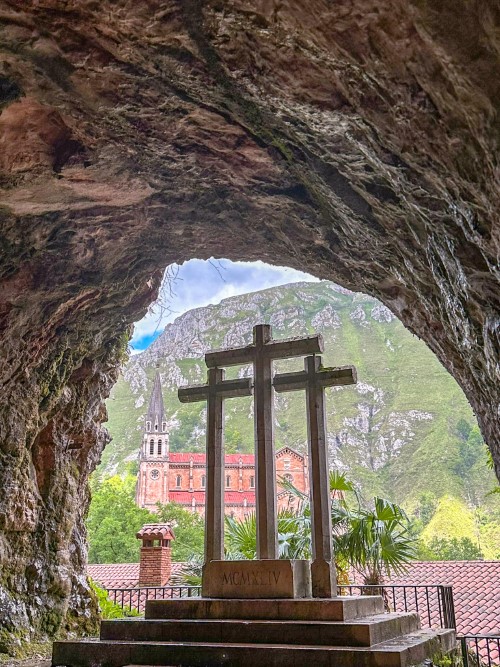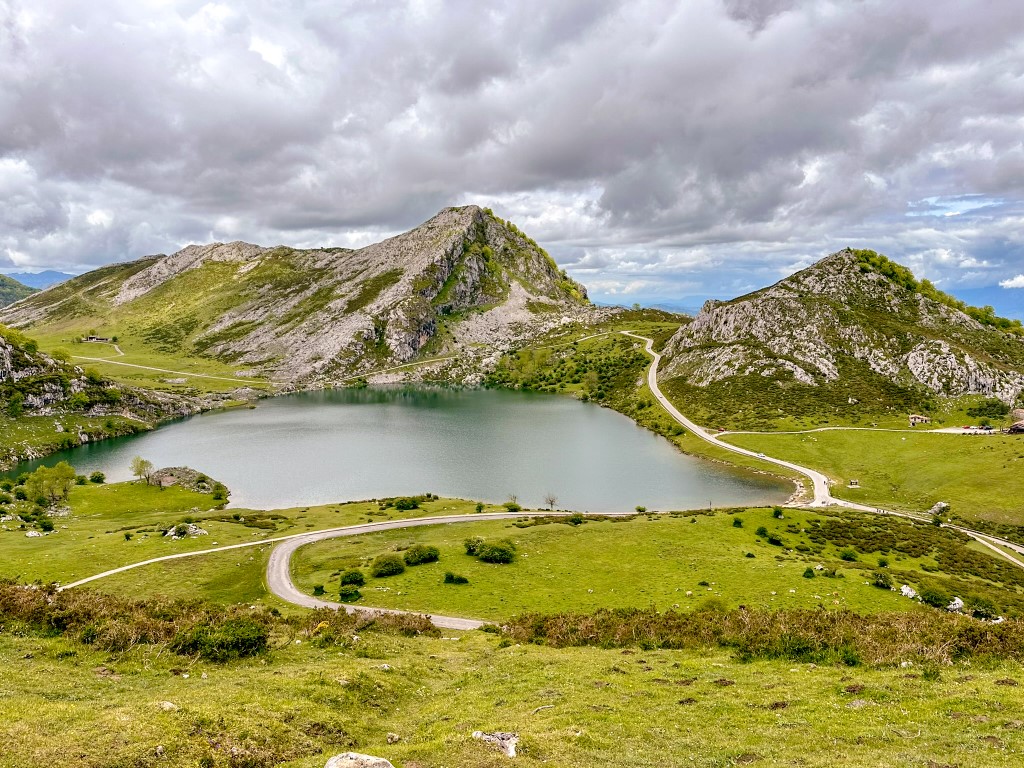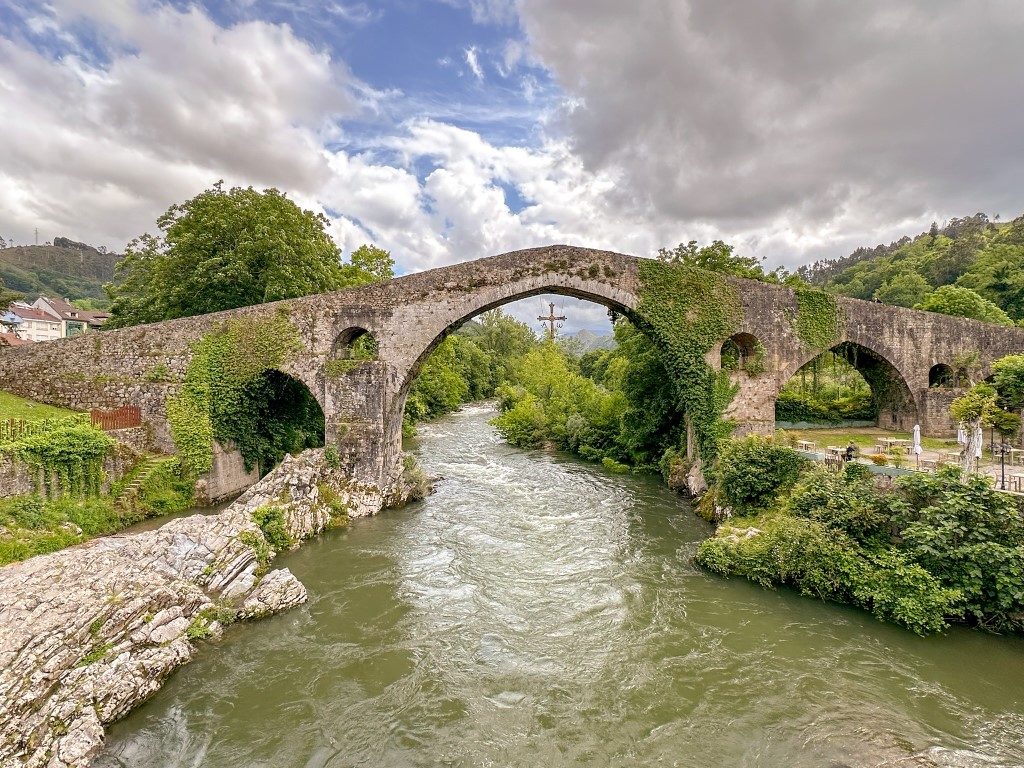With the big adventure behind us now and our calves still reminding us, we were understandably feeling like a gentler activity the next day (our last in the mountains) and I suggested that we drive to Cangas de Onis and catch the tourist shuttle up the mountain to the remote Lagos de Covadonga (the Covadonga Lakes.)
The road is described in my guide book as “not a road for nervous drivers..” and in the high season it is blocked altogether when the shuttle bus plies the route. We arrived at the shuttle departure point, could see the bus stop but no sign of activity and the boom gate positioned to block traffic from starting up the mountain road was open. We asked some people that we saw driving down and they said that the shuttle hadn’t started the season yet and the road was “ok but had lots of slow traffic.”
How hard can it be I said and being the adventurous type, off we went.
It started well, a few hairpin curves, relatively wide, saw a few cars and BIG buses coming down, a piece of cake.. but, in order to gain the 1000m in elevation that it does, it then gets pretty hairy. Very steep gradients, the road cut into the side of the cliff in places, massive tour buses coming down at very inopportune times and the occasional cow or three wandering down the road completed the picture.
At one stage we could see a large traffic jam ahead us on the road and I decided to pull in to a look out and let that pass. The views were spectacular and after a couple of large coaches had come down we thought it safe to continue up the mountain, however, a little further up we came across the reason for the traffic jam. A rental van had tried to avoid an oncoming car on a particularly narrow stretch and the right hand wheels had gone over the edge and whilst not a sheer cliff it looked precarious. The driver and his passenger were waiting in a safe spot for rescue and as we passed Russell went a whiter shade of pale than he had already been and there was silence from Fiona in the back seat. 🤦♀️ I was actually enjoying the drive, my only regret not being able to appreciate the view.
After encountering a bit more traffic and a few more cows, beautiful Lake Enol, the larger of the two main lakes, came into view and it was worth every heart stopping moment on the road.
We drove up and over the hill and Lake Ercina came into view, complete with a tiny restaurant and a fair amount of day trippers and some serious hikers.
We parked the car and had a bit of a wander but the ground was VERY wet underfoot (somehow I was wearing hiking sandals) and Fi and I were also still recovering from our epic walk the day before so we didn’t venture too far.
(We were to realise later that the respiratory symptoms and tiredness we all came to feel over the coming days was in fact Covid! It made Fiona and I even more proud of our achievement on the Ruta del Cares which was in retrospect Day 1 😢)

Anyway, oblivious to this at the time, we did the short walk up to the saddle that gave views of both lakes but that was enough for both of us. We reconvened with Russell in the car park, it was pretty cold and a unanimous decision to head back down.
Some time later and safely off of the mountain, we decided to investigate the easier to access but no less well known sites, the first of which was the Santa Cueva de Covadonga or Holy Cave of Covadonga.
“THE SHRINE WITHIN THE HOLY Cave of Covadonga is dedicated to the Virgin of Covadonga. But though the cave is now linked to Christianity, it’s believed it was first a site for prehistoric pagan worship.
Covadonga is an important site in Christian history. It was where Christian forces in Iberia defeated a Muslim army at the Battle of Covadonga, marking the beginning of the Spanish Reconquista.
According to Christian tradition, the cave was where Pelagius of Asturias, a Visigoth nobleman and founder of the Kingdom of Asturias, found a statue of the Virgin Mary that a hermit had erected. The statue then later miraculously helped his forces defeat their enemies. According to another version of history, Pelagius and a group of Christian refugees sought refuge in the cave, where they found safety and fed on honey from the bees that lived there. The Christian troops then returned after their victory at the Battle of Covadonga to place the statue there.”


Whatever you believe it is an important spiritual site and we climbed the stairs to where several people were worshipping in the tiny chapel before continuing through the tunnel which connects to the precinct dominated by the spectacular Basilica de Santa Maria la Real de Covadonga.


Built between 1877 and 1901 and constructed entirely of pink limestone it is a magnificent Neo- Romanesque Church that dominates the skyline. We had a look inside (less magnificent) and then made our way back down the hill to the car and then on to Cangas de Onis.
Cangas de Onis claims to be the “first capital of Christian Spain” and is where Pelayo, a Visigoth noble set up his court in the 8th century.
The reason for our visit though was to check out the Roman bridge, five spans wide and with the Picos mountains in the background a very photogenic spot.

Crossing the car bridge and walking back over the (quite steep) Roman bridge was enough for us today (with our soon to be confirmed Covid symptoms 😜) and we headed back to our accommodation just over an hour away.
This was our last day in the mountains so we had a bit of packing up and consolidating to do before moving on the next day, this time to the beautiful city of León.






